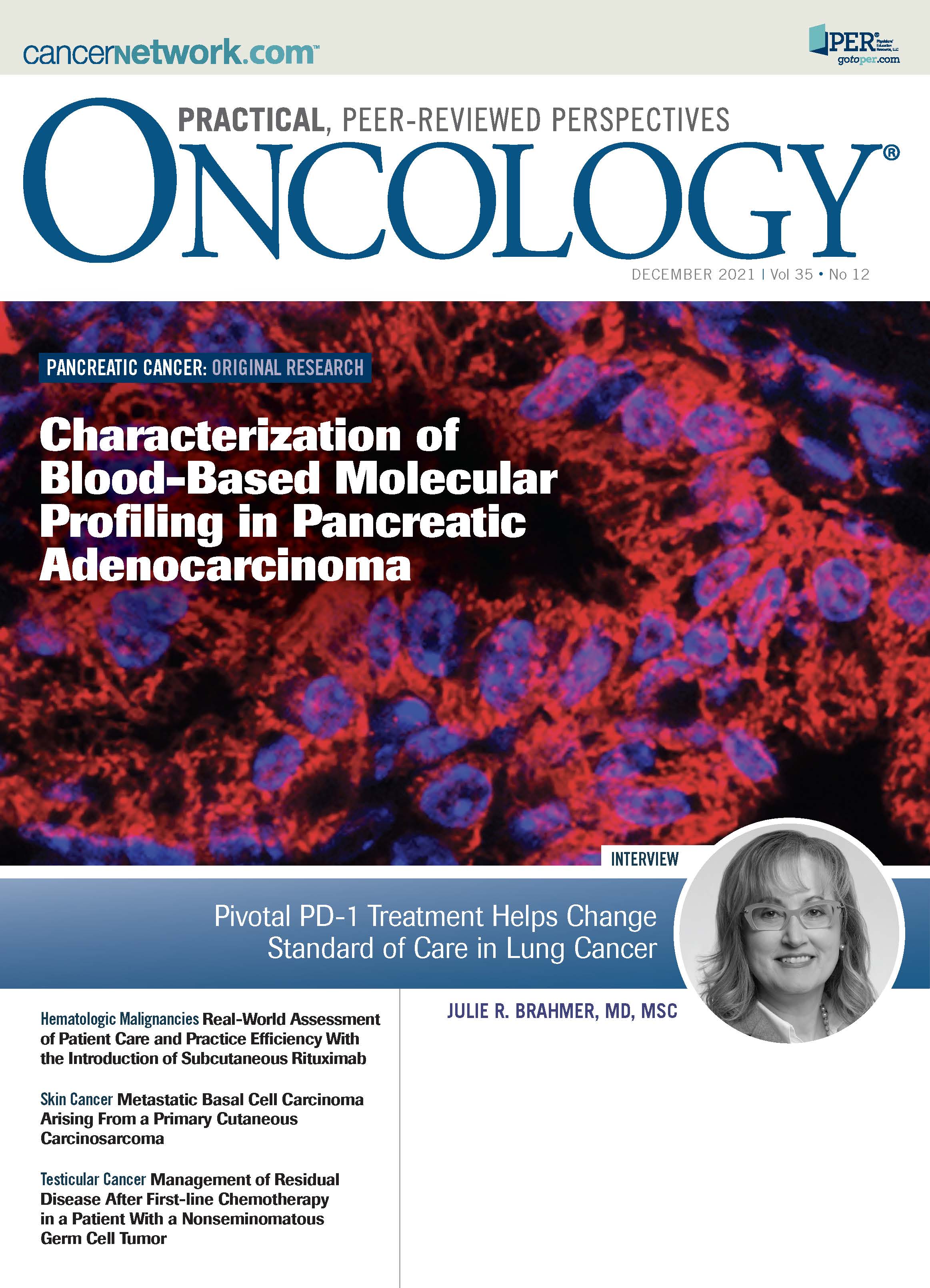A New Horizon in Cancer Care: Liquid Biopsy
Mehmet Sitki Copur, MD, gives his perspective on liquid biopsies and how they can be utilized in gastrointestinal cancer.
Copur is a medical oncologist/hematologist and medical director of oncology at Morrison Cancer Center, Mary Lanning Healthcare in Hastings, Nebraska, and is a professor at the University of Nebraska Medical Center adjunct faculty. He is also an Editorial Advisory Board member of ONCOLOGY®.

Thanks to innovations in liquid biopsy platforms within the past decade, the oncology world is witnessing the transformation of precision medicine in cancer care. The first FDA approval of a liquid biopsy test was the CellSearchCTC enumeration platform in 2013, which is centered on the detection of circulating tumor cells (CTC) in blood.1 In 2016, the FDA approved the first circulating tumor DNA (ctDNA) blood test, cobas EGFR Mutation Test v2, to detect EGFR gene mutations in patients with non–small cell lung cancer (NSCLC).2 In 2020, the FDA approved 2 additional comprehensive genomic profiling liquid biopsy tests, Guardant360 CDx and FoundationOne Liquid CDx, which both utilize next-generation sequencing technology to detect tumor genomic alterations in cell-free ctDNA in blood.3,4 Although Guardant360 CDx can detect changes in more than 60 different genes that are relevant in solid tumors, FoundationOne Liquid CDx can identify mutations or alterations in 300 or more genes.
In this issue of the journal, Christine Chung, DO, and colleagues5 report on the biologic and clinical correlates of genomic alterations in 77 consecutive patients with pancreatic ductal adenocarcinoma (PDAC), utilizing the Guardant 360 CDx blood-based molecular profiling test. This timely article reflects the current momentum in the use of liquid biopsies as an alternative to traditional tissue biopsies. The current standard, tissue-based molecular profiling, is more invasive, not always easy to perform, and takes longer to produce results.6 Blood-based molecular profiling testing, on the other hand, is fairly new. Despite recent advances, there remain uncertainties; one is determining the standardization of the timing of blood collection and extraction methods, and another is determining the assay cutoffs for ctDNA or CTC positivity.7 The possibilities of false-positive or false-negative results exist as well. Currently, the FDA recommends confirmation of negative results from Guardant 360 CDx or FoundationOne Liquid CDx tests with a tissue biopsy test. Similarly, the 2021 National Comprehensive Cancer Network Clinical Practice Guidelines state that cell-free ctDNA testing should not replace a histologic tissue diagnosis unless a patient is medically unfit for invasive tissue sampling. While in most instances a positive mutation, such as BRCA, BRAF, EGFR, or FGFR, directs the targeted treatment decision, confirmation of a negative mutation may also have implications for the treatment, as in the case of KRAS wild-type tumors in patients with colon cancer.
Although the guidelines are not well established, basic tumor biology principles may help in the liquid- vs tissue-biopsy decision. The higher the tumor burden, the higher the yield may be for the detection of ctDNA in blood-based molecular testing. In a patient with early-stage cancer, or in a patient with metastatic cancer whose tumor is responding well to current treatment, tumor shedding may not be high enough to detect ctDNA in blood. In this group of patients, tissue biopsy may be more appropriate. On the other hand, in a patient with metastatic cancer whose tumor is progressing while on or soon after treatment, blood-based molecular testing may be more applicable and may provide a quick answer for the next treatment choice.
In the retrospective review done Chung et al, initial staging of patients varied from stage I to IV; the largest proportion (48%) had stage IV disease at diagnosis. Blood from 35 of 77 (45%) patients showed 1 or more genetic alterations, with a median number of 3 alterations per patient. The most commonly altered gene was TP53, followed by KRAS, BRCA2, SMAD4, and CDKN2A. Of the patients with alterations, 36% had 1 or more potentially actionable mutation, most commonly BRCA2 (12%); this was followed by STK11, KRAS, PIK3CA, NF-1, EGFR, and FGFR.
The humbling fact is that so far, no agents have been approved against the most commonly identified mutations in PDAC, other than the PARP inhibitor olaparib (Lynparza). Clinical trials testing other agents are limited as well. In addition to finding targeted treatment options, other valuable uses of liquid biopsy technology can be the application of serial liquid biopsy testing in patients who are currently on treatment and assessing ctDNA quantitively to predict response and long-term clinical benefit. Likewise, monitoring patients who have completed curative therapy using blood-based molecular testing could be a valuable tool to determine risk of recurrence.
Despite the increasing popularity of liquid biopsy testing in cancer care, its current use seems to be mainly confined to advanced-stage patients as it is in this study by Chung et al. However, in addition to its potential in diagnosing cancer, guiding treatment decisions, and monitoring for treatment resistance, several studies are now underway to investigate how the commercial liquid biopsy tests might track minimal residual disease. Ongoing research is also exploring the utility of liquid biopsy in early-stage cancers as well as in detecting cancers in asymptomatic, average-risk individuals. Two liquid biopsy early-detection tests are making their way through clinical trials: The LUNAR-2 test is designed to detect colorectal cancer in asymptomatic, average-risk individuals, and the Galleri test may detect more than 50 types of cancer, including pancreatic cancer.8-10 An advantage of the Galleri test is that it may be able to pick up cancers for which we have no effective screening test, such as pancreatic cancer. It is encouraging to see that blood-based molecular testing is being increasingly integrated into a variety of pivotal clinical trials, supporting the view that this technology will be part of tomorrow’s standard of care.
References
- What is the CELLSEARCH circulating tumor cell (CTC) test? CellSearch. Accessed October 21, 2021. https://bit.ly/3vyTbd3
- FDA approves first blood test to detect gene mutation associated with non–small cell lung cancer. News release. FDA; June 1, 2016. Updated March 1, 2019. Accessed October 21, 2021. https://bit.ly/3jr6DLf
- Guardant Health Guardant360 CDx first FDA-approved liquid biopsy for comprehensive tumor mutation profiling across all solid cancers. News release. Guardant Health; August 7, 2020. Accessed October 21, 2021. https://bit.ly/3B4SkSK
- FDA approves Foundation Medicine’s FoundationOne Liquid CDx, a comprehensive pan-tumor liquid biopsy test with multiple companion diagnostic indications for patients with advanced cancer. News release. Foundation Medicine; October 8, 2020. Accessed October 21, 2021. https://bit.ly/3Gbt7tC
- Chung C, Galvin R, Achenbach E, et al. Characterization of blood-based molecular profiling in pancreatic adenocarcinoma. Oncology (Williston Park). 2021;35(12):XX-XX. doi:10.46883.ONC.2021.3512.0XXX
- Sehayek O, Onn A, Roisman LC, et al. The turnaround time impact of liquid biopsy in comparison with tissue biopsy in advanced NSCLC. International Association for the Study of Lung Cancer 2020 Hot Topic Meeting: Liquid Biopsy – Worldwide Virtual Event; October 2-3, 2020; virtual. Abstract VP01.33.
- Merker JD, Oxnard GR, Compton C, et al. Circulating tumor DNA analysis in patients with cancer: American Society of Clinical Oncology and College of American Pathologists joint review. J Clin Oncol. 2018;36(16):1631-1641. doi:10.1200/ JCO.2017.76.8671
- Beer TM, McDonnell CH, Nadauld L, et al. Interim results of PATHFINDER, a clinical use study using a methylation-based multi-cancer early detection test. J Clin Oncol. 2021;39(suppl 15):abstr 3010. doi:10.1200/JCO.2021.39.15_suppl.3010
- Klein EA, Richards D, Cohn A, et al. Clinical validation of a targeted methylation-based multi-cancer early detection test using an independent validation set. Ann Oncol. 2021;32(9):1167-1177. doi:10.1016/j.annonc.2021.05.806
- Lee J, Kim HC, Kim ST, et al. Multimodal circulating tumor DNA (ctDNA) colorectal neoplasia detection assay for asymptomatic and early-stage colorectal cancer (CRC). J Clin Oncol. 2021;39(suppl 15):abstr 3536. doi:10.1200/JCO.2021.39.15_suppl.3536

Newsletter
Stay up to date on recent advances in the multidisciplinary approach to cancer.